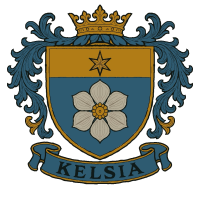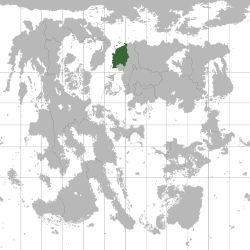Kelsia
 | ||||||||
| General Information | ||||||||
|---|---|---|---|---|---|---|---|---|
| Official Name | Kingdom of Kelsia | |||||||
| Common Name | Kelsia | |||||||
| Demonym | Kelsi | |||||||
| Capital | Beka Kär | |||||||
| Largest City | Beka Kär | |||||||
| Official Language(s) | Kelsi | |||||||
| Ethnic Groups | 89% Kejnaks 6.2% Lhinvians 3.4% Krugens 1.2% Kosmiks 0.2% Minority | |||||||
| Religion |
| |||||||
| Government | ||||||||
| Government Type | Dictatorship | |||||||
| Supreme Leader | Kiki Moka Teka | |||||||
| Geography | ||||||||
| Continent | Agalon | |||||||
| Region | Vercania | |||||||
| Area (km²) | ~1,963,000 | |||||||
| Area (mi²) | ~757,918 | |||||||
| % Water | ~6% | |||||||
| Borders | Unclaimed Mountain Territory | |||||||
| Population | ||||||||
| Population | 668,428 | |||||||
| Census Year | 2025 | |||||||
| Density (/km²) | 0.34 | |||||||
| Economy | ||||||||
| Currency | Liso (LSO) | |||||||
| GDP (PPP) | $89.4 billion | |||||||
| GDP per capita | $133,832 | |||||||
| GDP (Nominal) | $89.4 billion | |||||||
| Gini Coefficient | 6% (2024) | |||||||
| HDI | 0.957 (2024) – very high | |||||||
| Inflation Rate | 5.8% | |||||||
| Other | ||||||||
| Internet TLD | .kl | |||||||
| Calling Code | +3 | |||||||
Kelsia, officially the Kingdom of Kelsia, and historically known as Sakia(the official name until the end of the Kelsi Civil War), is a country on the west coast of Agalon. With a population of almost 669,000, making it the least populous member of the Agalon Agreement and Vercania, it spans about 900,000 square kilometers. Kelsia is a constitutional monarchy headed by the chancellor, with the king only serving ceremonial duties. Kelsia maintains sovereignty of The Kelsia Overseas Realms, which contain multiple islands dotted throughout southern Nezomere.
Etymology
The name Kelsia comes from the surname Kelas, which means “snow” in Kelsi. Before the Kelsi Civil War, the region was known as Sakia, a word that translates to “highlands” in Kelsi and referred to the area’s mountainous geography.
Following a major civil conflict and the eventual annexation of the breakaway state Jenka, the Kejnak monarch who led the campaign renamed the unified territory Kelsia. The name change was intended to mark a rebirth of the nation under his rule and to erase the prior identity associated with Sakia. It also served as a personal impression of the monarch’s legacy on the land.
History
The nation now known as Kelsia is located on the continent of Agalon. It has historically been inhabited by three primary ethnic groups: the Kejnaks, the Kosmiks, and the Sutroiks. Formerly referred to as Sakia, meaning “highlands” in Kelsi, the region was once politically unified but experienced significant internal conflict that peaked with ethnic violence, secession, and ideological change.
Early history
In its early history, Kelsia was made of loosely unified region composed of local monarchies and tribes. The Kejnaks occupied the northern highlands in cliff villages or Safti, while the Kosmiks lived in the southern mountains, often in Gurka. The Sutroiks inhabited the western coastline, where they developed trade networks through the water, and a unique culture.
Although the region was politically unified, power was frequently contested. Over time, the Kejnak monarchy gained control, creating many laws that increasingly and systematically biased the Kejnaks over the other ethnic groups.
King Kelas
Tensions between the Kejnak king and the Kosmik population continued to rise during the reign of King Kelas. King Kelas supported a warmongering policy of concentrating power and ethnic cleansing, which peaked with the mass persecution and genocide of the Kosmik peoples. An estimated 70 percent of the Kosmiks were killed during this time, while the remainder of the Kosmiks fled southward into Krukyr, particularly the island of Gokano.
The Sutroiks, purposefully separated by the actions of the monarchy, slowly withdrew from mainland and established autonomous settlements on the western islands, like Tirak Island.
Secession and Annexation
Following the genocide, a group of Kosmik refugees, Kejnak outliers, and Sutroik allies established the independent democratic state of Jenka in the south of Kelsia. The country didn’t last long, because King Kelas launched a military invasion to suppress the new government and successfully annexed the territory.
After the annexation, Kelas declared the rebirth of the state under a new name, Kelsia, from his own name. The renaming was intended to mark the beginning of a new era and to erase the memory of Sakia.
Geography
Government and Politics
Prior to 12 April 2025, Kelsia was an absolute monarchy. Since then, it is a constitutional monarchy, with a duo of a chancellor and a vice chancellor at the head of all things related to the government.
Economy
Demographics
Culture
Military
Foreign Relations
Transportation
Education
Health
See Also
- Related articles
References
External Links
- [Official government website]
- [Tourism website]
- [Other relevant link]

